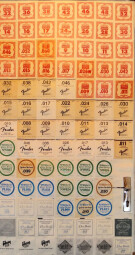For many years, when we were forced to leave our comfortable home to buy strings, we trusted our favorite salesman to recommend us an adequate set. Thanks to the Internet, there is no need to waste such energy now... But it is easy to get lost with all the options available. Here are some tips to avoid choosing strings based solely on the packaging.
String gauge
It is basically the diameter of the strings. It is expressed in inches, and even in tenths or even hundredths of an inch, which explains why they read 8, 0.8 or 0.08, all of which correspond to the same thickness.
The thicker the strings, the tighter and, thus, harder. It makes your notes and chords sound fuller and with more sustain. On the contrary, thin strings are softer because they are not as strained. As such they are easier to play, but they have less presence and sustain.
There are lots of gauges, especially for electric guitars, and some people even pick each string individually. Just as with “signature” guitars, several legendary guitar players have their own set of string sets with exotic gauges, like David Gilmour who has 10–48 and 10,5–50 gauge sets.
But, if you are a beginner, I recommend you to stay on the safe side and go with the most usual ones:
- Light 9–42
- Custom Light 9–46
- Regular 10–46
In most cases it won’t be necessary to modify the settings of your instrument if you use these classic sets. But if you see the strings are too close to the neck or that they are dangerously distancing from the frets: refrain from adjusting the string height at the bridge because you might risk misadjusting the whole instrument. Let a professional adjust your guitar’s truss, it will spare you unnecessary fears.
Metal
In order to make things easier for beginners, we will limit ourselves to two types of strings: “stainless steel” and “nickel plated steel.” Saying that one is better than the other would be like saying that Fender is better than Gibson (or the other way around). It’s all a matter of taste.
- Nickel plated steel
They are soft to the touch and slide very well under the fingers. They are rather flattering, with a slight bump in the mids. Nickel plated steel strings age progressively in terms of brilliance and sustain.
- Stainless steel
Steel has a rougher texture, which is an advantage for those who like to fill the threads. It provides percussive highs and deep lows. But it loses its brilliance faster that nickel.
It’s good to know that there are flat-wound and halfwound strings with an additional coating in pure nickel… but if you are just starting out keep it simple and don’t throw a monkey wrench into the works.
Finally, you are probably asking yourselves:
“What about brands? He hasn’t mentioned any brands!”
Guilty! Because in my view that’s the last question that a padawan ought to ask. Each brand has its own peculiarities, which would fill up a whole book. Simply stick to the tried-and-true brands (D’Addario, Dean Markley, Ernie Ball, GHS, DR… ) depending on your budget.


